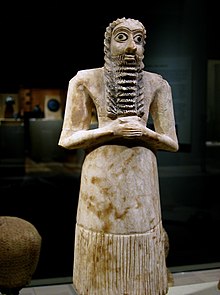

| Part of a series on |
| Ancient Mesopotamian religion |
|---|
 |
|
|
The Hymn to Enlil, Enlil and the Ekur (Enlil A), Hymn to the Ekur, Hymn and incantation to Enlil, Hymn to Enlil the all beneficent or Excerpt from an exorcism is a Sumerian myth, written on clay tablets in the late third millennium BC.[1]
- ^ Miguel Ángel Borrás; Centre de Cultura Contemporània de Barcelona (2000). Joan Goodrick Westenholz, The Foundation Myths of Mesopotamian Cities: Divine Planners and Human Builder in "La fundación de la ciudad: mitos y ritos en el mundo antiguo". Edicions UPC. pp. 48–. ISBN 978-84-8301-387-8. Retrieved 3 June 2011.